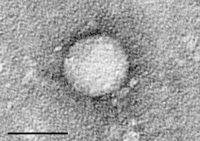
Photo from wikipedia
Abstract HCV NS5B polymerase has been one of the most attractive targets for developing new drugs for HCV infection and many drugs were successfully developed, but all of them were… Click to show full abstract
Abstract HCV NS5B polymerase has been one of the most attractive targets for developing new drugs for HCV infection and many drugs were successfully developed, but all of them were designed for targeting Hepatitis C Virus genotype 1 (HCV GT1). Hepatitis C virus genotype 4a (HCV GT4a) dominant in Egypt has paid less attention. Here, we describe our protocol of virtual screening in identification of novel potential potent inhibitors for HCV NS5B polymerase of GT4a using homology modeling, protein–ligand interaction fingerprint (PLIF), docking, pharmacophore, and 3D CoMFA quantitative structure activity relationship (QSAR). Firstly, a high-quality 3D model of HCV NS5B polymerase of GT4a was constructed using crystal structure of HCV NS5B polymerase of GT1 (PDB ID: 3hkw) as a template. Then, both the model and the template were simulated to compare conformational stability. PLIF was generated using five crystal structures of HCV NS5B (PDB ID: 4mia, 4mib, 4mk9, 4mka, and 4mkb), which revealed the most important residues and their interactions with the co-crystalized ligands. After that, a 3D pharmacophore model was developed from the generated PLIF data and then used as a screening filter for 17000328 drug-like zinc database compounds. 900 compounds passed the pharmacophore filter and entered the docking-based virtual screening stage. Finally, a 3D CoMFA QSAR was developed using 42 compounds as a training and 19 compounds as a test set. The 3D CoMFA QSAR was used to design and screen some potential inhibitors, these compounds were further evaluated by the docking stage. The highest ranked five hits from docking result (compounds (p1–p4) and compound q1) were selected for further analysis. Communicated by Ramaswamy H. Sarma
Journal Title: Journal of Biomolecular Structure and Dynamics
Year Published: 2019
Link to full text (if available)
Share on Social Media: Sign Up to like & get
recommendations!